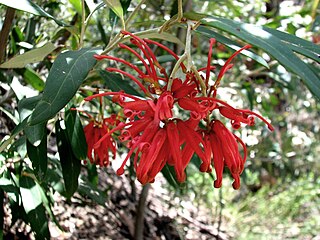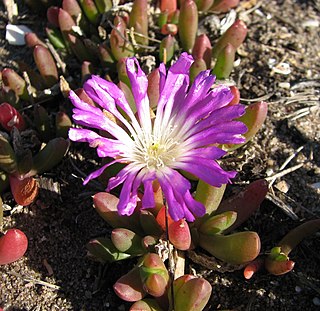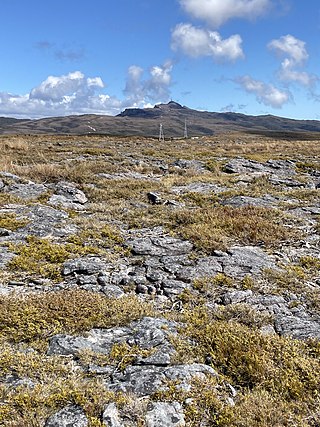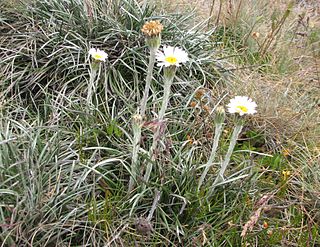
This article relates to the flora of New Zealand, especially indigenous strains. New Zealand's geographical isolation has meant the country has developed a unique variety of native flora. However, human migration has led to the importation of many other plants as well as widespread damage to the indigenous flora, especially after the advent of European colonisation, due to the combined efforts of farmers and specialised societies dedicated to importing European plants & animals.

Celmisia is a genus of perennial herbs or subshrubs, in the family Asteraceae. Most of the species are endemic to New Zealand; several others are endemic to Australia.

Grevillea victoriae, also known as royal grevillea or mountain grevillea, is a species of flowering plant in the family Proteaceae and is endemic to mountainous regions of south-eastern continental Australia. It is an erect to spreading shrub with elliptic to lance-shaped leaves, and pendulous clusters of red to orange flowers.

Disphyma is a genus of flowering plants in the family Aizoaceae that are native to New Zealand, Australia and southern Africa. Plants in this genus are prostrate, annual or short-lived perennial shrubs with succulent leaves and daisy-like flowers arranged singly on the ends of shoots with petal-like staminodes, many stamens and usually five styles.

Damnamenia is a genus of flowering plants in the family Asteraceae.

Celmisia spectabilis, also known as cotton daisy or by its Māori name puharetaiko, is a mountain daisy in the family Asteraceae, and is endemic to New Zealand, where it is one of the most widespread species in the genus Celmisia.

Olearia macrodonta is a small sub-alpine evergreen tree endemic to New Zealand, from the plant family Asteraceae. It is closely related to the narrow-leaved Olearia ilicifolia, with which it shares several characteristics including largely undulating and serrated grey-green leaves. These common characteristics mean the two species are often confused with one another. It is found in lowland to sub-alpine forests from the East Cape of the North Island of New Zealand southwards throughout the South Island and Stewart Island, at 450–1,200 metres (1,480–3,940 ft) in altitude.

Denniston Plateau is an 18 km long, 600–800 m high coalfield plateau in the Papahaua Range on the West Coast of the South Island of New Zealand. A combination of impermeable rock, high rainfall, and shallow acidic soil has created a unique ecosystem of stunted trees and heath-like vegetation which is home to numerous endemic and undescribed species of plants and invertebrates. The plateau contains rich seams of high-quality coal, which led to the creation and abandonment of the mining towns of Denniston and Millerton, and the current Stockton Mine. Plans to create a new open-cast mine on the southern part of the plateau have become an environmental controversy.

Olearia arborescens, also known as common tree daisy and pekapeka by Māori, is a common shrub or small tree of New Zealand. It has also been called the Glossy Tree Daisy and the Forest Tree Daisy. It grows in lowland to alpine scrubland in the North Island from East Cape southwards, and throughout the South and Stewart Islands. Olearia arborescens was previously known as Solidago arborescens.

Celmisia pugioniformis, commonly known as slender snow-daisy, is a species of perennial herb in the family Asteraceae. It is native to south-eastern Australia. Leaves are 10 to 20 cm long and 2 to 6 mm wide, with an olive green or grey green upper surface. The daisy-like flowerheads, which are 6 to 8 cm in diameter, appear between December and February in the species native range. The species was formally described in 1992 in the Flora of New South Wales. Prior to 1992, plants had been included under the name Celmisia asteliifolia.

Myosotis pansa subsp. pansa, also known as the Waitakere forget-me-not, is a subspecies of flowering plant in the family Boraginaceae, endemic to the North Island of New Zealand. Lucy Moore described the variety M. petiolata var. pansa in 1961, and it was transferred to a subspecies of M. pansa by Heidi Meudt, Jessica Prebble, Rebecca Stanley and Michael Thorsen in 2013. Plants of this species of forget-me-not are perennial rosettes with ebracteate inflorescences and white corollas with exserted stamens.

Celmisia angustifolia, called the strap-leaved daisy, is a species of flowering plant in the genus Celmisia, native to the South Island of New Zealand. It has gained the Royal Horticultural Society's Award of Garden Merit.

Celmisia haastii is a perennial alpine plant species of the family Asteraceae, native to New Zealand.

Hierodoris eremita is a moth of the family Oecophoridae. It is endemic to New Zealand and found in the areas around Aoraki / Mount Cook and Westland Tai Poutini National Park areas. This species inhabits alpine herbfields at altitudes of around 900–1400 m. Larvae are said to have been reared on the leaves of plants in the Celmisia genus. Pupation happens on the host plant. The adults of this species is on the wing between December and June. This species is day flying.

Celmisia major is a species of daisy that is endemic to New Zealand. It is split into two different varieties, Celmisia major var. major and Celmisia major var. brevis. Despite being in the same species, it is thought that the two varieties are not close to one another, with botanist Peter James de Lange stressing critical study on the taxonomy of the daisies. It was first described by Thomas Cheeseman in 1925. The major variety is found in the Auckland area and nearby islands, while the brevis variety is confined to Mount Taranaki.

Celmisia verbascifolia is a species of daisy that is endemic to New Zealand. It was first described by Joseph Dalton Hooker in 1853.

Celmisia gracilenta, commonly known by its Māori name Pekapeka, is an alpine plant of Asteraceae in the genus Celmisia, found at a latitude of 37° southwards in New Zealand.

Celmisia sessiliflora, the white cushion mountain daisy, is a species of Celmisia native to alpine environments of the South Island of New Zealand.

Raoulia grandiflora, or the large-flowered mat daisy, is a species of flowering plant from the South Island of New Zealand.




















